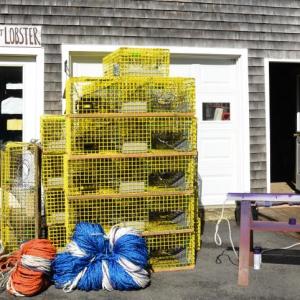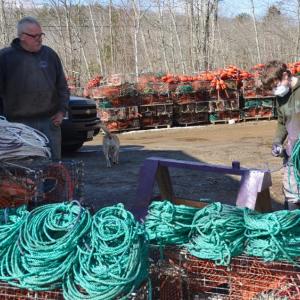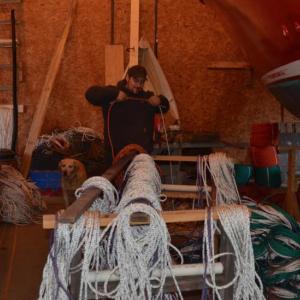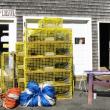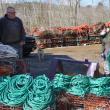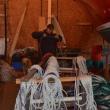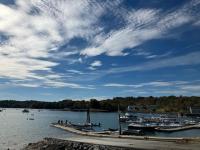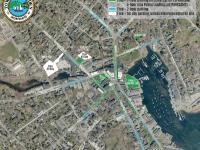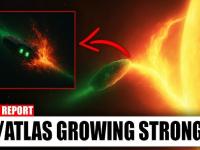Maine lobstermen spray-paint trap lines for whale entanglement study
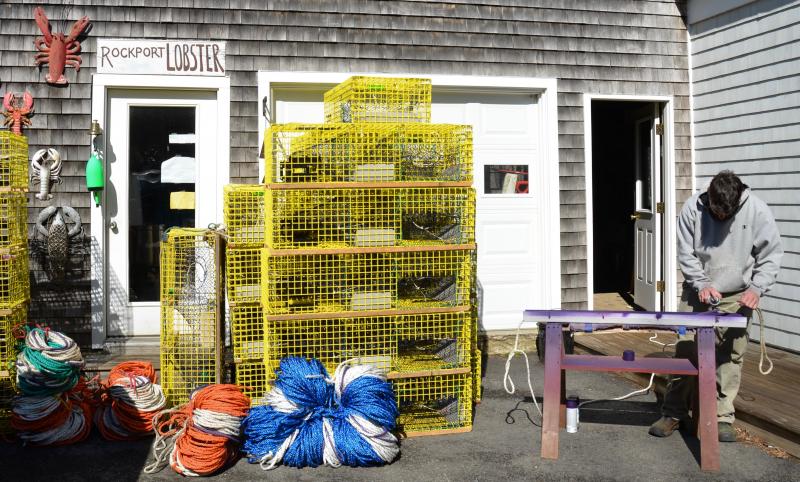 Devon Yaeger, who works with Rockport Lobster, paints the lobster trap lines with purple paint, preparing for the 2020 lobster season. The state and federal government this year is directing lobstermen to paint their lines in order to help determine whose — U.S., Canada — lines are prone to tangling around whales in the Gulf of Maine. (Photo by Lynda Clancy)
Devon Yaeger, who works with Rockport Lobster, paints the lobster trap lines with purple paint, preparing for the 2020 lobster season. The state and federal government this year is directing lobstermen to paint their lines in order to help determine whose — U.S., Canada — lines are prone to tangling around whales in the Gulf of Maine. (Photo by Lynda Clancy)
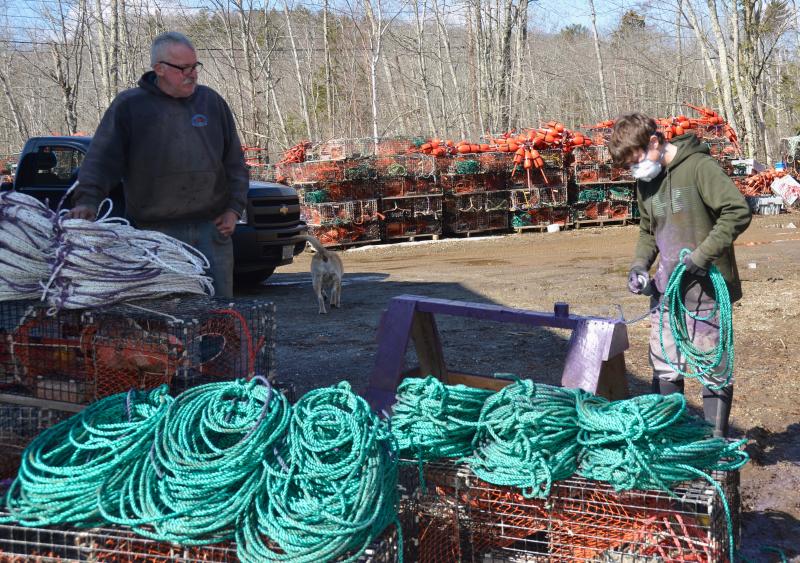 Rockport fisherman Kenneth Dodge and one of his sternmen, Damian Weaver, with all the lines to which purple paint needs to be applied. (Photo by Lynda Clancy)
Rockport fisherman Kenneth Dodge and one of his sternmen, Damian Weaver, with all the lines to which purple paint needs to be applied. (Photo by Lynda Clancy)
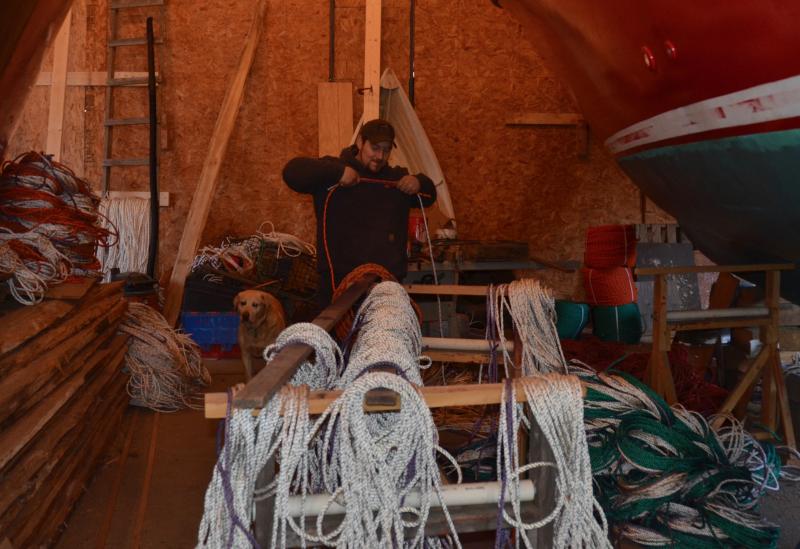 Ralph Jones gets the lines in order for the 2020 lobster season. (Photo by Lynda Clancy)
Ralph Jones gets the lines in order for the 2020 lobster season. (Photo by Lynda Clancy)
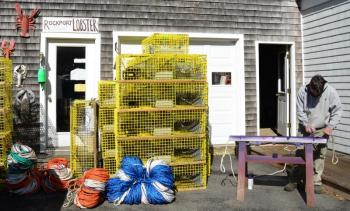 Devon Yaeger, who works with Rockport Lobster, paints the lobster trap lines with purple paint, preparing for the 2020 lobster season. The state and federal government this year is directing lobstermen to paint their lines in order to help determine whose — U.S., Canada — lines are prone to tangling around whales in the Gulf of Maine. (Photo by Lynda Clancy)
Devon Yaeger, who works with Rockport Lobster, paints the lobster trap lines with purple paint, preparing for the 2020 lobster season. The state and federal government this year is directing lobstermen to paint their lines in order to help determine whose — U.S., Canada — lines are prone to tangling around whales in the Gulf of Maine. (Photo by Lynda Clancy)
 Rockport fisherman Kenneth Dodge and one of his sternmen, Damian Weaver, with all the lines to which purple paint needs to be applied. (Photo by Lynda Clancy)
Rockport fisherman Kenneth Dodge and one of his sternmen, Damian Weaver, with all the lines to which purple paint needs to be applied. (Photo by Lynda Clancy)
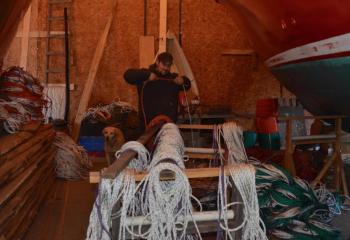 Ralph Jones gets the lines in order for the 2020 lobster season. (Photo by Lynda Clancy)
Ralph Jones gets the lines in order for the 2020 lobster season. (Photo by Lynda Clancy)
PENOBSCOT BAY — Purple spray paint has been a hot commodity along the coast of Maine this past late winter and early spring, as lobstermen buy out their local stores for a specific task: painting sections of their lobster trap lines to mark them as being solely from Maine.
This chore — and it is a laborious one — involves staking out the lines, feeding them over sawhorses or other temporary stands — and spraying them in three-foot sections with a distinctive dark purple hue.
Stores up and down the coast special-ordered quantities of purple paint this winter in anticipation of a state-inspired data collection effort, spearheaded by the Maine Department of Marine Resources. With approximately 4,500 commercial lobstermen in the state setting up to 800 traps each, that is a lot of purple spray paint.
For those who got a jump on the lobster season, the job was underway in late February, indoors, amidst fumes of acetone and toluene. For others, it has been an outdoor project, long and messy.
But the lobstermen mostly agree that at least the state and National Oceanographic and Atmospheric Administration will gather definitive evidence indicating whose lines — U.S., Canadian, from Maine or other states — are entangling the endangered North Atlantic Right Whales in the Gulf of Maine and Atlantic Ocean.
Maine specific gear marking was part of a proposal Maine put forward to NOAA, and has implemented through its own rulemaking process with an effective date of September 1, 2020.
Right Whales, which are classified as endangered species and with a population of an estimated 400, migrate alone or in small groups along the East Coast and into Canadian waters to feed, before heading back down the coast to the warmer waters of Florida and Georgia to birth and begin raising their young.
Along their routes toward Cape Breton, they can get trapped by nets and lines lying on the ocean floor, refuse from the fishing industry.
They are also susceptible to strikes by ships and boats, and get disoriented by manmade ocean noise, which interferes with their communication. (See a February news release, Listening for Right Whales in the Gulf of Maine, for more about noise.)
Last year, the Take Reduction Team, an advisory body to the National Marine Fisheries Services, proposed measures to reduce risk of harm to Right Whales, rules that resulted in much debate, especially from Maine fishermen, many of whom set traps close to the shore.
The measures included reducing the number of trap lines afforded to lobstermen. This would require grouping set number of traps onto the lines, or trawls, as they are called. fishermen had argued that reducing the number of lines would create a safety, economical and logistical hardship.
The Maine Department of Marine Resources listened the fishermen, agreeing that the whales rarely travel inshore. Gov. Janet Mills said the rules were overly draconian because the majority of the Right Whale entanglements were offshore.
“....It is clear to me – as it is to you – that the federal government’s pending regulations are unfair, unreasonable, and unwarranted,” said Gov. Mills, in July 2019. “I will not stand idly by as Washington attempts to threaten your livelihoods and our way of life.”
She argued further: “There is a disturbing lack of evidence connecting the Maine lobster industry to recent right whale deaths. To the contrary, the six right whale deaths in Canada this year, in addition to the three right whales recently discovered entangled in Canadian waters, are evidence that the Maine lobster fishery is not the primary problem for right whales.”
As the debate continued over the summer, the DMR conducted its own analysis of data to gain a better understanding of risk so it could develop a proposal that is more effective for whales and fishermen, said the DMR, in mid-April.
In January, the DMR proposed a number of alternative resolutions, including that Maine would have the, “flexibility to develop regional measures that achieve conservation benefits equivalent to those in the plan,” according to the DMR. “This was included in recognition of the unique fishing practices, differing oceanographic conditions, and safety concerns along Maine's coast.”
The DMR proposed exempting inshore fishermen, who often have smaller boats, from the vertical line reduction rule. The exempted waters include Penobscot Bay and the islands, out to the would be three miles out from shore, otherwise known as the exemption line. (See the DRM map for details)
Outside that line, from three to six miles, the trawl length would specify eight traps per single endline.
“Longer trawls recognize higher whale sightings in federal waters while the flexibility to fish four versus eight traps supports diversity of fishing practices and ensures equivalent conservation value,” the DMR said.
Beyond that, from six to 12 miles from shore, the minimum trawl length would be 15 traps per two endlines, or eight traps per single endline. And further out from that, 12 miles to to the boundary of the Lobster Management Area, the minimum trawl length would be 25 traps per two endlines.
Up until now, all Northeast trap lines and pot gear is identified by a red mark. That has changed to purple, and now, a: “purple Maine-only gear mark is required at the top, middle, and bottom of the vertical line. The top mark is 36 inches in length and must be in the top two fathoms of the line. The middle and bottom marks are 12 [inches] in length.”
Additionally, the DMR has proposed that all Maine commercial lobster license holders will be required to complete a harvester report (currently, 10 percent of the commercial lobstermen are asked to report).
Maine is also asking National Marine Fisheries for autonomy in deciding conservation measures. This “conservation equivalency within the proposed rule,” would allow the states lobster management zones to use their authority to implement measures that achieve equivalent conservation outcomes.
“This would enable zones to consider the diversity of the fleet and address safety issues that arise when trawling up and using weak points in vertical lines,” the DMR said.
With the goal of NOAA to reduce North Atlantic Right Whale entanglement in U.S. commercial pot/trap fishing gear by 60 percent, the federal agency has set 2020 as the year to establish new rules to protect those whales.
Maine’s purple lines are to provide more data for the rule-making.
“Location-specific marks will provide more targeted data for researchers and regulators trying the determine the origin of gear involved in an entanglement,” said Jeff Nichols, who is spokesman for the DMR. “Currently, gear from several Atlantic Coast states carry the same markings so it is impossible to tell what fishery the lines on entangled whales actually comes from. Location-specific marks will also allow researchers and regulators to differentiate gear found on entangled whales from Maine gear.”
This gear-marking was first presented to the National Marine Fisheries Take Reduction Team in April 2019.
“It had its origins in discussions Maine DMR had with industry the previous summer (2018) in preparation for the TRT meeting in April 2019,” said Nichols.
Meanwhile, in February, NOAA said it was incorporating a new decision support tool to use when drafting the Right Whale protection rules.
NOAA said that the team of scientists who reviewed the tool: “concluded that the decision support tool provides a useful and open way for industry and managers to compare relative changes in entanglement risk for right whales under various scenarios. The reviewers also pointed out strengths and weaknesses to consider when making decisions based on the outputs, and as we work to improve the tool.”
The tool overlays gear and whale density by area and season and measures risk posed based on rope strength, “ for example, stronger rope can mean higher risk of a serious or lethal entanglement,” NOAA said. “The result is a relative risk ‘score’ for given scenarios of when, where, and how fishing occurs.”
“The tool uses decades of right whale sighting location data overlaid with what we know about fishing gear distribution and density from Industrial Economic's peer reviewed co-occurrence model used by the Agency since 2013 and Duke University's habitat based whale density model,” said NOAA.
NOAA said it will use this new tool, as well as other data and information, to achieve its goal of 60 percent entanglement risk reduction.
“We expect to publish a proposed rule and draft environmental impact statement in summer 2020 and will accept public comments in writing and during scheduled public meetings from Rhode Island to Maine.”
NOAA also said it will continue to work with stakeholders, and Canada, “to continue to support both whale recovery and sustainable fisheries.”
Reach Editorial Director Lynda Clancy at lyndaclancy@penbaypilot.com; 207-706-7756
Event Date
Address
United States

